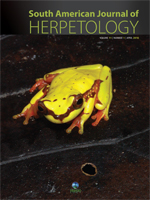Protected areas (PAs) cover a small proportion of the Earth's surface and most species are not covered by the current network. Amphibians are the least represented group in PAs around the world and expanding the network is still the major recommendation for species conservation. We evaluated the effectiveness of PAs in safeguarding endemic amphibians in the Cerrado biome of Minas Gerais state, southeastern Brazil. We conducted a gap analysis to highlight site-based conservation actions for target species within study site. We extracted occurrence points from the national database and calculated the intersection between the minimum convex polygon and natural vegetation remnants for each species. For each target species, we calculated the percentage of the range covered by PAs and assessed the scientific knowledge based on academic publications between 1950–2015. We recorded 206 amphibians in Minas Gerais, of which 127 occur in the Cerrado. We identified 24 target species and concluded that 80% are insufficiently protected by the current PA network. A quarter of the species have zero coverage and most species have < 30% of their range legally protected. In southwestern Minas Gerais, we recommend habitat restoration and connectivity to provide additional habitat to target species. In western Minas Gerais, the creation of PA seems to be the best solution. The distribution of target species is concentrated in the Espinhaço Mountain Range, where we recommend the establishment of biodiversity corridors. We examined 246 publications, most of which focus on taxonomy. Few species have sufficient information to have their conservation status re-assessed, with only 26.8% of publications containing specific information on conservation. Scientific knowledge must be improved for all research areas, especially species distributions and ecology, to support evidence-based conservation and management actions.
How to translate text using browser tools
1 April 2016
Downscaling the Gap: Protected Areas, Scientific Knowledge and the Conservation of Amphibian Species in Minas Gerais, Southeastern Brazil
Izabela M. Barata,
Vivian M. Uhlig,
Graziele H. Silva,
Guilherme B. Ferreira
ACCESS THE FULL ARTICLE
Cerrado
DD species
endemic species
geographical information system
Protected areas effectiveness
representativeness





